M Labs Technologies TC05 GPS Tracker User Manual
Montage Systems, Inc. GPS Tracker
User manual

New Product Requirement
Asiatelco Technologies Co. Proprietary/Confidential
User manual
Contents
1 Introduction .............................................................................................................................. 2
2 ID and Tooling Design ................................................................................................................ 4
3 Hardware Requirements ........................................................................................................... 5
3.1 Basic Hardware Requirements ......................................................................................... 5
3.2 Basic RF Performance Requirements ................................................................................ 7
3.3 Certification and Safety Requirements ............................................................................. 9
4 Software Requirements ........................................................................................................... 10
4.1 Basic Software Requirements ......................................................................................... 10
4.2 Remote Update ............................................................................................................... 10
4.2.1 Auto Execute .............................................................................................................. 10
4.3 Power Modes .................................................................................................................. 10
4.4 AT Command .................................................................................................................. 11
4.5 Report ............................................................................................................................. 13
4.6 Reset ............................................................................................................................... 13
4.6.1 Context Preservation .................................................................................................. 13
4.7 Startup Banner ............................................................................................................... 13
5 Test Plan .................................................................................................................................. 14
5.1 Hardware Test ................................................................................................................. 14
5.2 Software Test .................................................................................................................. 14
6 Package Requirement .............................................................................................................. 16
6.1 Package Content ............................................................................................................. 16
7 Required Project Schedule ...................................................................................................... 16
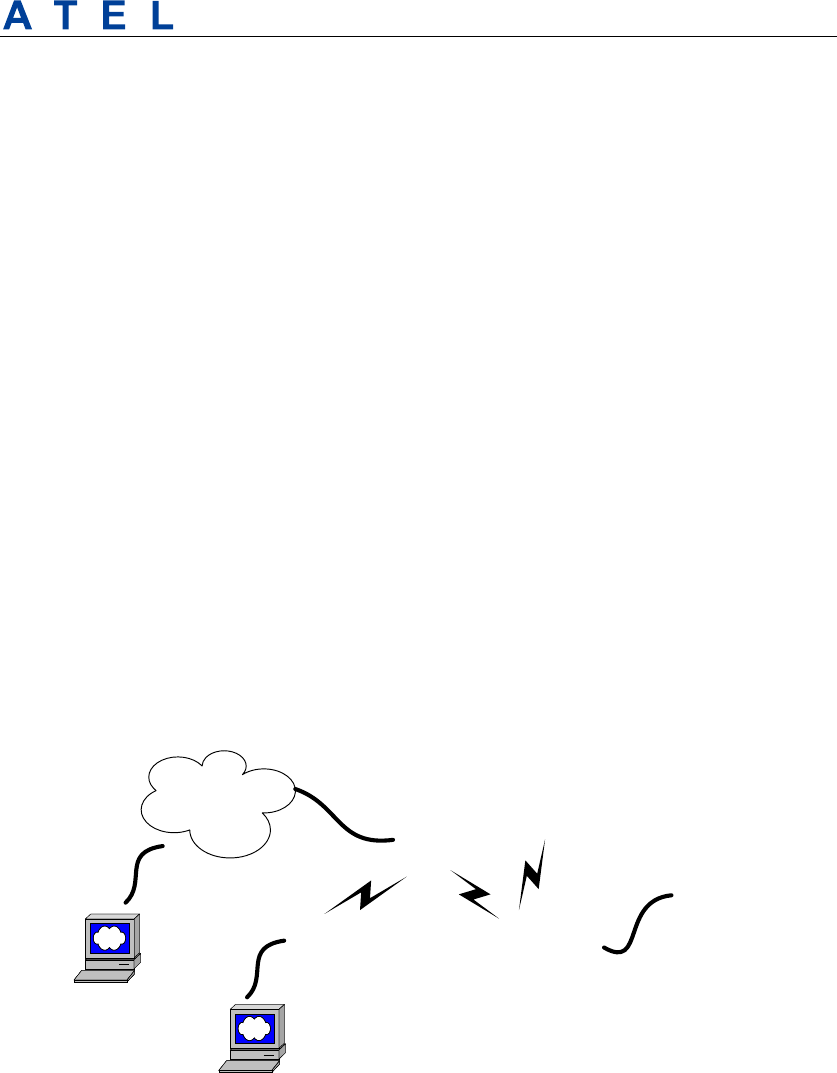
New Product Requirement
Asiatelco Technologies Co. Proprietary/Confidential
1 Introduction
The MC891G is a self-contained vehicle tracking device that combines GPS location with
CDMA connectivity.
Logically, the ION appears to a user or a server application as a single endpoint device. It can
be queried, updated and configured either through a serial connection, or an over the air
CDMA IP connection, or through SMS messaging. The MC891G presents itself over these
connections as an enhanced cellular modem with attached functional elements. These
elements include:
GPS location engine
2 General Purpose Bidirectional I/O (GPIO) pins
1 Relay drive pin output
Serial UART port
Input voltage monitor (optional)
Tim e r s
Watchdog lockup protection (Dedicated watchdog circuit is optional)
Fa ct o ry load option for motion detection
Access to these elements and general purpose interfaces is done through an extended AT
command set as defined herein.
Application scene:
This product will be designed based on the VIA CBP8.2 CDMA 1X 800M&1900M Baseband
chipset, which includes GPS functionality, ARM CPU and CDMA protocol. This baseband
external connection 256M serial flash, CDMA 800M/1900M/GPS RF Transceiver, and RF
Front end circuit.
The device will use one dual band antenna(CDMA800&CDMA1900)and one dedicate GPS
antenna.
Internet
Server
(IP)
Server
(SMS)
IP
CDMA
Network
OTA
ION-X
GPS
Car

New Product Requirement
Asiatelco Technologies Co. Proprietary/Confidential
Marketing Information
Item Description
Potential market America
Product Design Requirement Cost: Low end
Expected sample Date
QTY of Samples
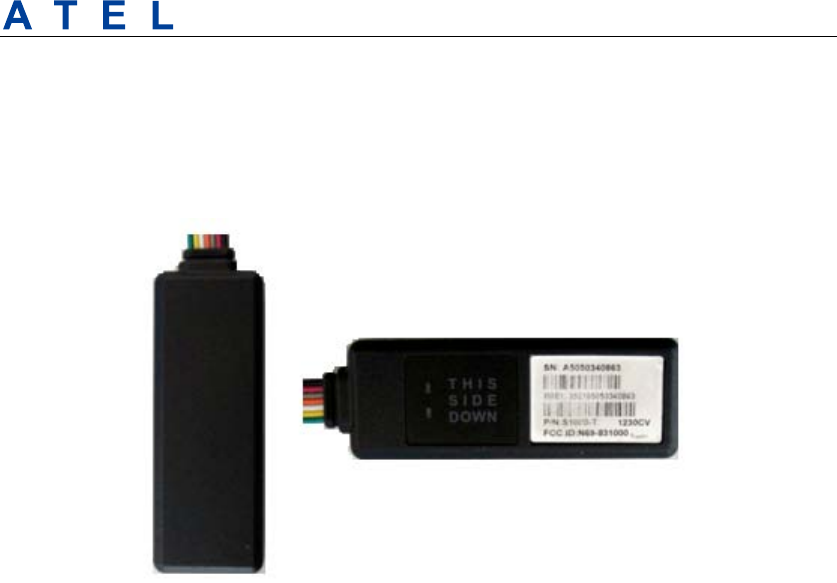
New Product Requirement
Asiatelco Technologies Co. Proprietary/Confidential
2 ID and Tooling Design
The product appearance is shown as follows:

New Product Requirement
Asiatelco Technologies Co. Proprietary/Confidential
3 Hardware Requirements
3.1 Basic Hardware Requirements
Items Requirement
Baseband Chipset VIA CBP8.2C/CBP8.2D
RF Transceiver FCI7790
Memory Serial Flash 256Mb
PSRAM 128Mb/6 4 M b (optional)
Air Interface CDMA 2000 1x, GPS
Frequency CDMA2000 1x: 800MHz,1900MHz
Antenna Internal Antenna(800M&1900M)
GPS Antenna Dedicate high performance ceramic antenna
UIM requirement No-UIM mode, UIM card connector optional
Interface UART TX
UART RX
12V DC Input(1A current)
Relay Drive (12V Output ,500mA current)
GPIO1
GPIO2
Battery Monitor internal analog input scaled (Optional)
Build in battery manager Required
Dedicate Timers No
Watchdog Required(Dedicate Watchdog is Optional)
Motion Detect Optional(GPS/Sensor)
LED 2 LED required
2 LEDs(one is RED,one is Green)
Battery Build in battery(80MAH Lion)
Working Time 4hours
Power switch No
Power Cable color 8 colors
Power Cable connector type 8 pin
Power Consumption < 5Watts
The MC891G provides support for specialized hardware features through extended AT
commands. The features supported include the following.
GPS
The major functionality of the GPS module is to compute the correlation results between the
incoming signal and the selected PRN code based on certain Carrier Doppler Frequency, Code
Doppler Frequency, code phase, carrier phase, and the particular satellite the module is
tracking or acquiring.
GPIO

New Product Requirement
Asiatelco Technologies Co. Proprietary/Confidential
Two GPIO pins, GP1 and GP2, are presented to the external environment on the main
connector. They are general purpose bidirectional lines capable of providing system
interrupts to generate a report or drive logic levels to external devices. These lines are 2.8V
logic level and are 15V tolerant. These pins default to input. GP1 is pulled down representing
0 when disconnected; GP2 is pulled up representing logical 1 when disconnected. They
should be asserted to a known value if used. GP1 is intended to use for Ignition Sensing.
LED’s
Two LED status indicators are provided to verify correct installation and operation. The
status LEDs are color coded and directly convey the status of the CDMA and GPS subsystems
as described in the table below. Their valid operation also indicates operational status and
power.
LED Function Status
Red GPS On: GPS satellites acquired and
Locked
Flash Slow: GPS satellite search is
in progress
Off: No power or GPS subsystem
fault
Green CDMA/CDMA Connection On: Indicates CDMA connection is
made
Flash Slow: CDMA subsystem
initialized but no connection
Flash Fast: CDMA initialization in
process
Off: No power or CDMA
subsystem fault
The ION provides user control allowing the LEDs to be extinguished once installation is
verified. This feature reduces power and further conceals the ION Tracker from untrained
parties wishing to defeat its operation.
UART
A UART port is provided for AT command and data interaction and optionally for application
specific control. When in power down mode, a character must be sent to the UART first to
wake it up. The port will stay awake for 5 seconds after any character received.
Relay Driver
A 500mA sink capable output pin is provided. This pin is meant to drive a relay coil indented
to interrupt the starter solenoid relay for the ignition circuit to a car.
Battery Monitor
The battery monitor is internal analog input scaled such that the DC value of the power input
pin to the ION system is measured. This value is scaled to span the most significant 8 bits of
the A/D and consequently covers a scale from 0 to 25.5 Volts.
Timers
Timers resident on the CDMA baseband chip generate periodic interrupts for power down
wakeup, watchdog support, report generation and other timer related functions. Report
timers are supported by related AT command and cause generation of periodic reports.
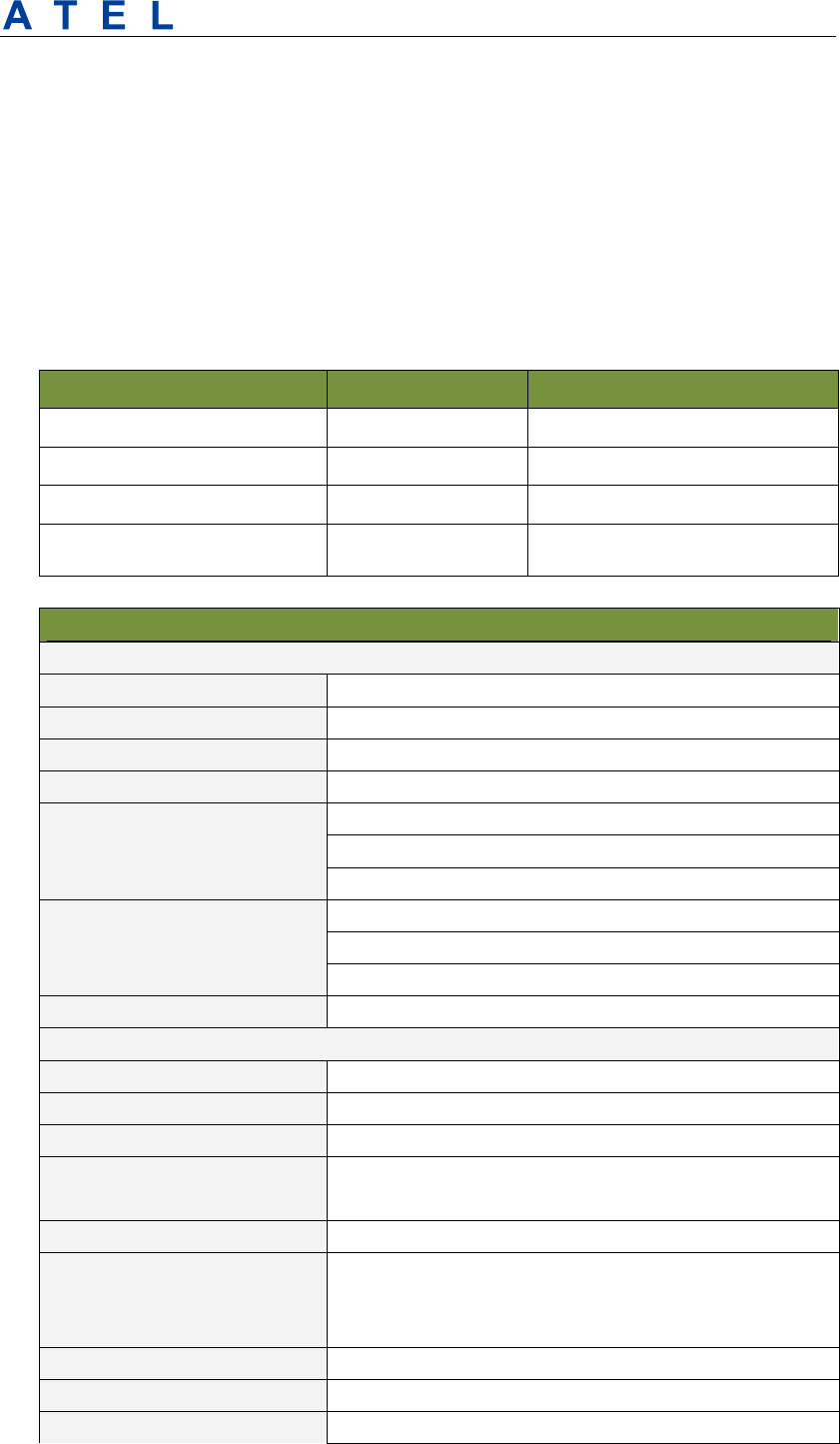
New Product Requirement
Asiatelco Technologies Co. Proprietary/Confidential
Watchdog
CBP8.2 chipset provide internal software Watchdog, and a physically dedicate Watchdog
circuit requirement is optional.
Motion Detect (Option)
A factory populates option for motion detector is provided. If populated at the time the
MC891G is manufactured, this option will work with firmware power down options to keep
the MC891G in a very low power down state until motion is detected. Upon wakening, a
report can then be generated.
3.2 Basic RF Performance Requirements
Items Requirements Remark
TRP free space >= 20 dBm TRP free space
TIS free space <= -104dBm TIS free space
Antenna loss <= -3 dB TRP-TX Power Conducted
Antenna Loss <= -3 dB RX receive sensitivity conducted –
TIS
Board RF Specification
Cellular Band RX
Frequency range 869MHz~894MHz
Sensitivity -108dBm (FER≤0.5%)
Dynamic range -25~-108dBm (FER≤0.5%)
Single tone Desensitization -102.4dBm(FER≤1%,-30dBm@±900KHz)
Intermediation Spurious
Response Attenuation
-102.4dBm(FER≤1%,-43dBm@±900 KHz/±1700KHz)
-91.4dBm(FER≤1%,-32dBm @±900 KHz/±1700KHz)
-80.4dBm(FER≤1%,-21dBm @±900 KHz/±1700KHz)
Conducted Spurious
Emission
<-76dBm/1MHz(RX band)
<-61dBm/1MHz( TX band)
<-47dBm/30KHz(other frequency)
Cellular Band TX
Frequency range 824MHz~849MHz
Maximum Frequency error ±300KHz
Maximum output power 24dBm [-3dB~~+2dB] ;
Minimum controlled output
power
<-50dBm
Standby output power <-61dBm
Code domain power
The code domain power in each inactive code channel
shall be 23 dB or more below the total output power
measured on both the I and Q data channel combined.
Time reference ±1.0uS
Waveform quality >0.944
Range of open loop output (test1:-25dBm/1.23MHz)-47.7±9.5dBm
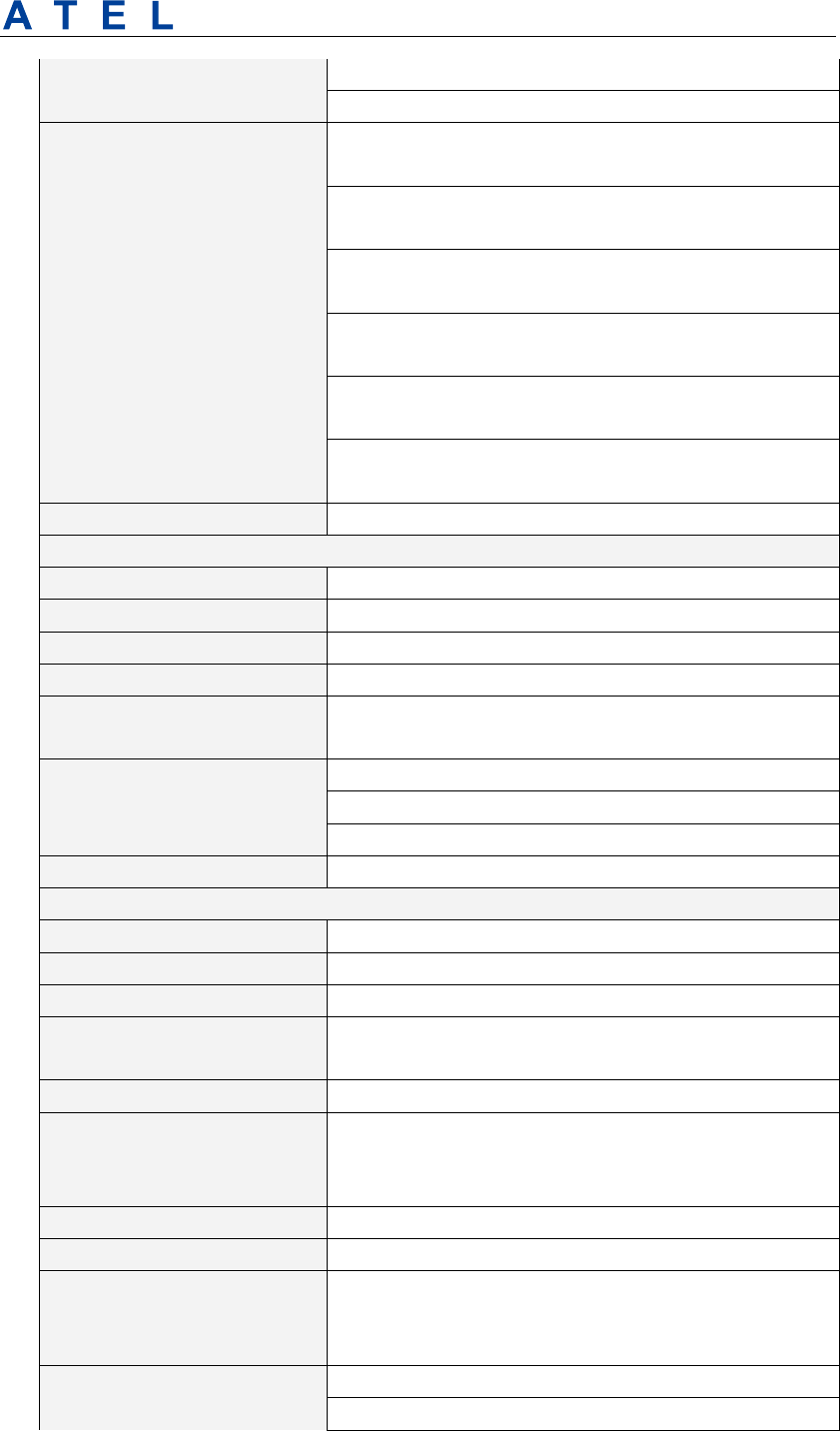
New Product Requirement
Asiatelco Technologies Co. Proprietary/Confidential
power (test2:-60dBm/1.23MHz)-7.7±9.5dBm
(test3:-93.5dBm/1.23MHz)20.3±9.5dBm
Conducted spurious emission
-42dBc/30Khzor-54dBm/1.23MHz
(|Δf|:1.25MHz~1.98MHz)
-50dBc/30Khzor-54dBm/1.23MHz
(|Δf|: 1.98MHz~4.00MHz)
<-36dBm/1kHz
(|Δf| > 4MHz, 9KHz < f < 150KHz,)
<-36dBm/10kHz
(|Δf| > 4MHz, 150kHz<f<30MHz,)
<-36dBm/100kHz
(|Δf| > 4MHz, 30MHz<f<1GHz)
<-30dBm/1MHz
(|Δf| > 4MHz, 1GHz<f<12.75GHz)
PCS Band RX
Frequency range 1930MHz ~ 1990MHz
Sensitivity -108dBm (FER≤0.5%)
Dynamic range -25 ~ -108dBm (FER≤0.5%)
Single tone Desensitization -102.4dBm(FER≤1%,-40dBm@±1250KHz)
Intermediation Spurious
Response Attenuation -102.4dBm(FER≤1%,-43dBm@±1250KHz/±2050KHz)
Conducted Spurious
Emission
<-76dBm/1MHz(RX band)
<-61dBm/1MHz( TX band)
<-47dBm/30KHz(other frequency)
PCS Band TX
Frequency range 1850MHz ~ 1910MHz
Maximum Frequency error ±150KHz
Maximum output power 23dBm [-3dB~~+2dB]
Minimum controlled output
power
<-50dBm
Standby output power <-61dBm
Code domain power
The code domain power in each inactive code channel
shall be 23 dB or more below the total output power
measured on both the I and Q data channel combined.
Time reference ±1.0uS
Waveform quality >0.944
Range of open loop output
power
(test1: -25dBm/1.23MHz) -50.7±9.5dBm
Conducted spurious emission (test2: -60dBm/1.23MHz) -10.7±9.5dBm
(test3: -91.3dBm/1.23MHz) 20.3±9.5dBm

New Product Requirement
Asiatelco Technologies Co. Proprietary/Confidential
-42dBc/30Khzor-54dBm/1.23MHz
(|Δf|:885KHz~1.98MHz)
-54dBc/30Khzor-54dBm/1.23MHz (|Δf|:
1.98MHz~4.00MHz)
<-36dBm/1kHz (|Δf| > 4MHz, 9KHz < f < 150KHz)
<-36dBm/10kHz (|Δf| > 4MHz, 150kHz<f<30MHz)
<-36dBm/100kHz (|Δf| > 4MHz, 30MHz<f<1GHz)
<-30dBm/1MHz (|Δf| > 4MHz, 1GHz<f<12.75GHz)
GPS
AGPS Support
Embedded AGPS software supporting an internal GPS
subsystem solution
E911 FCC mandated phase 1 and phase 2 (optional1)
Frequency Support
L1-band (1.57542GHz)
Channels: 210 PRN, 66 Search, 22 Simultaneous
tracking
Sensitivity
Sensitivity (UHIS):
Tracking: -156dBm
Reacquisition: -153dBm
Acquisition: -144dBm
Tracking Time Requirement
Acquisition time:
Hot: <2s
Warm: <30s
Cold: <60s
Reacquisition: 2s - 10s Depends on signal level
3.3 Certification and Safety Requirements
Items Requirement
Drop Design 1.2meter 6 direction standard drop test
Temperature Range -40 to 85°C Operation
-50 to +100° C Storage
Humidity: 20% to 90% Operation
10% to 95% Storage
Altitude: -500 to +18,000m
Vehicle ISO Test ISO+7637-2-2004; ISO+7637-3-2007; ISO_10605-2008;
ISO+16750-2-2010
FCC Certification FCC 47 CFR Part 2、Part 22 and Part 24
Safety UL Listing
Others Operator Requirement Industry Canada/ AT&T (optional)
ESD Requirement 15KV non-conductive
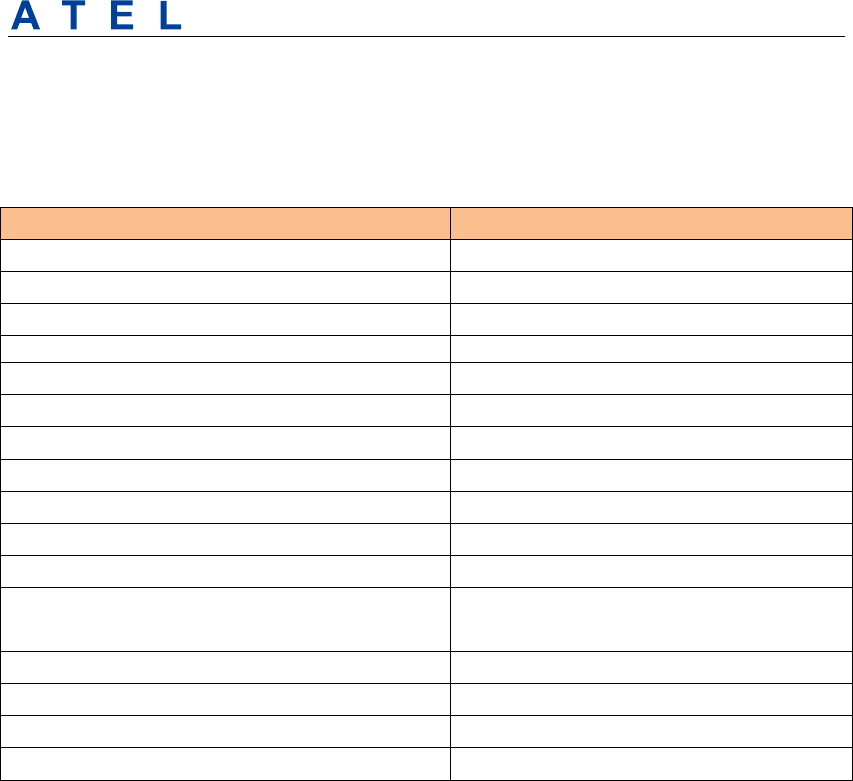
New Product Requirement
Asiatelco Technologies Co. Proprietary/Confidential
4 Software Requirements
4.1 Basic Software Requirements
Items Requirement
Air Interface CDMA 2000 1x 800/1900MHz; GPS
1x Data Required
IP Stack Ipv4/IPV6
Upgrade Method Remote update / PC tool
RUIM Optional
Compatible with None-RUIM Required
Remote Update Required
Power Modes Required
AT Command Required
Report Required;3000records
Driver GPIO,LED,GPS,UART
GPIOs
Interrupt for Door Open Detect, Ignition
Status
LEDs GPS Status, CDMA Status
Watch Dog Required (CBP8.2 integrated)
Reset Soft reset
Startup Banner Required
4.2 Remote Update
The MC891G supports OTA field upgrades of the MC891G resident application. An over the
air TFTP (Trivial File Transfer Protocol) connection is made over a UDP/IP connection. A
replacement file is then transferred from a server to the MC891G and that file replaces the
previous application image.
4.2.1 Auto Execute
The Auto Execute Utility copies the contents of file system.exf into system executable RAM
and executes it from there. This file is the factory default application. Another file named
custom.exf can be loaded into the file system.
Auto Execute will look first for a file named update.exf and load and execute that in place of
custom.exf if it exists. If update.exf executes successfully, the previous copy of custom.exf is
deleted from the file system and update.exf is renamed to custom.exf.
4.3 Power Modes
The MC891G device supports several power modes that are set by the power mode
command. In full power mode the cellular subsystem will maintain a persistent cellular
connection whenever service is available as well as an IP connection where available.
Any hardware or software reset will interrupt any power mode and return the device to full
power mode. In summary, the conditions permanently restoring full power mode include:

New Product Requirement
Asiatelco Technologies Co. Proprietary/Confidential
Power cycle
Watchdog timeout
Reset command
CDMA phone call reset
SMS or UART power mode command
Motion detect (if detector installed and enabled)
When in a power down mode, the following resources will cause interrupts that will wake
the MC891G and cause it to attempt complete the function associated with the interrupt.
Simultaneous interrupts will cause sequential completion of each associated function. These
interrupts include:
Report timer
GPIO change
Battery threshold
Heartbeat
Watchdog
Power-up
The related interrupt function will be attempted for a total duration set the associated
parameter in the power mode command.
4.4 AT Command
MC891G commands are AT extensions specific to MC891G devices. They are closely based on
commands that are as similar as possible to other industry common devices and are
essentially subsets of standard ION commands. Common commands used with CDMA
modems supporting IP connectivity are not included within the MC891G command set
extensions. These commands are left in their native structure, as defined by the respective
baseband CDMA chip supplier which product already in use.
Command Summary
The following commands are highly specialized to the MC891G. The commands listed are
intended to be similar to counterparts found in common CDMA modem command
extension.
1. AT+IONAA: Set append mode
2. AT+IONACK: Set acknowledgement mode
3. AT+IONAPN: Set APN
4. AT+IONBIN: Read the factory core software version (read only)
5. AT+IONBZ: Buzzer setting
6.AT+IONCV: Configuration version
7. AT+IONDI: Set distance interval interrupt

New Product Requirement
Asiatelco Technologies Co. Proprietary/Confidential
8. AT+IONDTE: Set driving time events
9. AT+IONFR: Restore factory defaults
10. AT+IONGF: Set geo fence borders
11. AT+IONGFH: Set geo fence around current location
12. AT+IONGPIO: GPIO Read/Write
13. AT+IONGS: GPS State report
14. AT+IONHB: Heartbeat
15. AT+IONHC: Heading Change
16. AT+IONINFx: List system information segments
17. AT+IONIP: Set target server IP address and port number
18. AT+IONIPC: IP Change report
19. AT+IONIS: Ignition State
20. AT+IONLT: LEDs’ Timing and Intensity
21. AT+IONLPORT: Set the local IP port number
22. AT+IONNR: Set time before IP session is closed and restarted
23. AT+IONNW: Set watchdog timeout if no network found
24. AT+IONPM: Set auto power down mode
25. AT+IONRF: Report Format - ASCII/Binary
26. AT+IONRI: Set report timer interval
27. AT+IONRM: Report Mask
28. AT+IONRN: Queue report record for transmission
29. AT+IONRR: Set reset report
30. AT+IONRS: Reset setting - soft/hard, periodic
31. AT+IONSD: Set SMS response destination
32. AT+IONSI: Set interrupt
33. AT+IONSQ: Set queue length
34. AT+IONSR: Set relay driver (GP3) state high or low
35. AT+IONSV: Read the factory application software version (read only)
36. AT+IONTA: Tow Alert
37. AT+IONTID: CDMA tower ID and location data
38. AT+IONUA: Update application firmware OTA

New Product Requirement
Asiatelco Technologies Co. Proprietary/Confidential
39. AT+IONUC: Update configuration files OTA
40. AT+IONVO: Virtual Odometer
41. AT+IONVTO: Virtual Trip Odometer
4.5 Report
The MC891G captures data and forms a report record with that data. This is a single data
structure intended to contain all of the typically useful data on the MC891G. Other
information can be queried separately using separate AT commands.
Reports are always generated by interrupts regardless of whether or not there is a GPS lock.
If no lock has ever been attained since hardware reset, default values of 0 are returned for
all GPS fields. If a lock has been attained and lost, the report will contain the last valid GPS
data including the timestamp of that data.
Base Requirements:
1. A report is generated in response to either an interrupt event or in response to
execution of associated AT commands explicitly requesting one.
2. GPS coordinates are stored in reports as signed hex values to save space.
3. To reduce data transmission costs, the data within a report record can be masked
and removed before it is transmitted.
4. Every report has a tag and each enabled interrupt or event generates a separate
report. The report tags indicate the cause of the generated report, which can be an
interrupt, an event or in response to a command.
4.6 Reset
There is an internal soft reset.
4.6.1 Context Preservation
When a reset is caused by the Network Watchdog or by the Reset command (modes 0,1),
the context of the system is being preserved and is restored after the reset. The context
includes all the periodic timers, the report queue, the odometer, etc. This allows to reset the
unit as a troubleshooting measure either periodically or due to Network Watchdog without
losing reports that are already in the queue or are pending on running timers. Note that the
reset process may cause 1-2min of inaccuracy in the timers and should not be considered as
very precise.
Modes 8/9 of the IONRS command perform soft and hard reset respectively without
preserving any context. Factory reset (IONFR) also does not preserve any context of the
system.
4.7 Startup Banner
After a reset a startup banner is printed through the UART only. The format and content of
the banner shown below:
FW:<firmware version>; BIN:<bin version>; MEID/ESN:<MEID/ESN>
APN1:<apn1 name>; IP:<IP>:<port>;LPORT:<lport>
RI:<s,v,t>; DTE:<t1,t2,t3>; DI:<t>; HB:<t>; NR:<t,c,r>; RS:<a,t,r>

New Product Requirement
Asiatelco Technologies Co. Proprietary/Confidential
5 Test Plan
5.1 Hardware Test
Test Item Description
Baseband Function Test • Power Input Test
• Power Consumption and Current Test
• Heat Dissipation Test
• UART Stability Test
• GPIO Level Test
• LED Stability Test
• Drop Down Test
• ESD Test
• High/Low Temperature Test
• Humidity Test
RF Test • RF Performance Test
• GPS Performance Test
• Antenna Performance Test
5.2 Software Test
Test Environment Construct
message Test environment
1.usb dongle and PC as message server
2.send message to IONX
UDP Test environment
1.connect dongle to PC and create dialup as ip server
2.IONX create IP connection to server
UART Test environment
1.connect IONX to pc with com serial cable
2.open Termial tool and send at command
3.reponse can be shown at terminal window
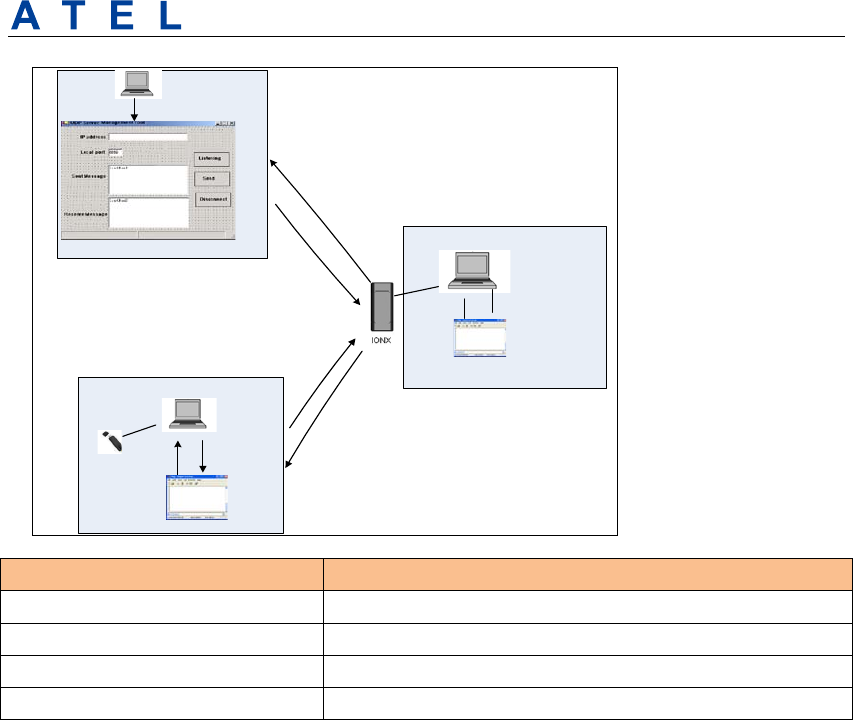
New Product Requirement
Asiatelco Technologies Co. Proprietary/Confidential
Test Items Description
Extension Features Test
CDG2/3 Test
Basic Function Test
Field Test
standard serial
connection
AT command Terminal
Send AT command
Response shown
at terminal
window
IP Server
USB
Send AT
command
Response shown at
terminal window
SMS Server
UART Port
IP server
Sent message to IONX
Response to SMS server
Connect to network
IONX create UDP connection
with IP server
Download firmware
from server
IP Server
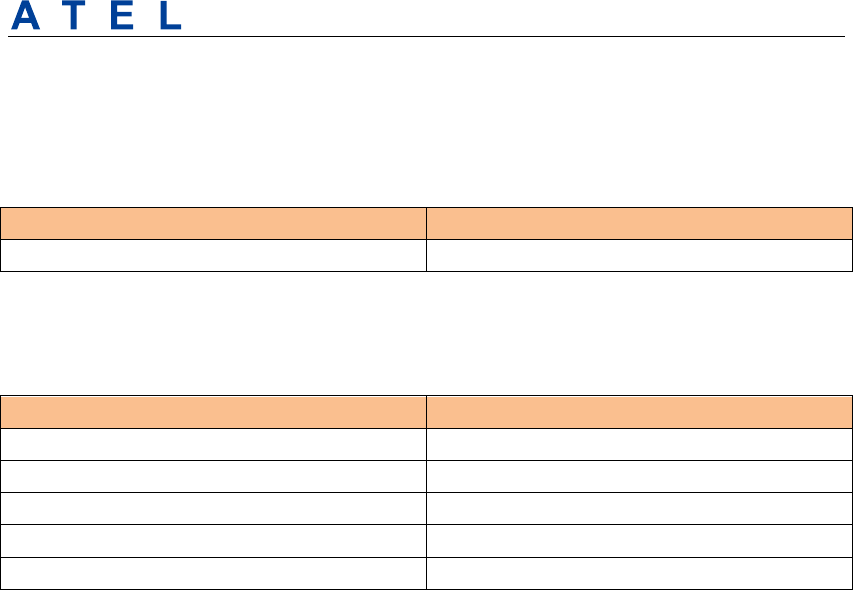
New Product Requirement
Asiatelco Technologies Co. Proprietary/Confidential
6 Package Requirement
6.1 Package Content
Items Quantity
7 Required Project Schedule
Items Date
Product Requirement Document Release T0+2
HW design T0+18
Engineer samples manufacture T0+35
SW and HW debug, Test T0+78
Homologation Samples delivery T0+81
FCC Statement
This equipment has been tested and found to comply with the limits for a Class B digital device,
pursuant to Part 15 of the FCC Rules. These limits are designed to provide reasonable
protection against harmful interference in a residential installation. This equipment generates
uses and can radiate radio frequency energy and, if not installed and used in accordance with
the instructions, may cause harmful interference to radio communications. However, there is
no guarantee that interference will not occur in a particular installation. If this equipment does
cause harmful interference to radio or television reception, which can be determined by turning
the equipment off and on, the user is encouraged to try to correct the interference by one or
more of the following measures:
-- Reorient or relocate the receiving antenna.
-- Increase the separation between the equipment and receiver.
-- Connect the equipment into an outlet on a circuit different from that to which the receiver is
connected.
-- Consult the dealer or an experienced radio/TV technician for help.
This device complies with part 15 of the FCC Rules. Operation is subject to the following two
conditions:
(1) This device may not cause harmful interference, and (2) this device must accept any
interference received, including interference that may cause undesired operation.
Changes or modifications not expressly approved by the party responsible for compliance
could void the user's authority to operate the equipment.
The antenna(s) used for this transmitter must be installed to provide a separation distance of
at least 20 cm from all persons and must not be co-located or operating in conjunction with any
other antenna or transmitter.